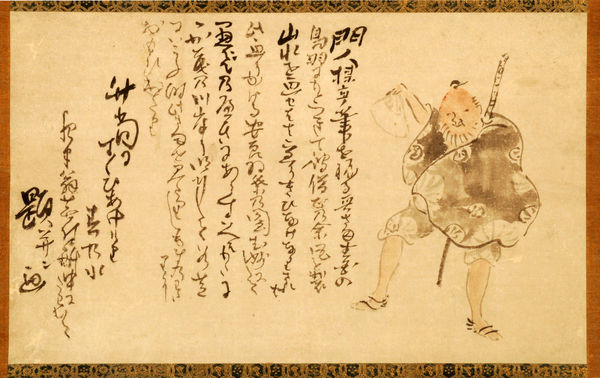"The Life of Japanese Paintings": Exhibition on view at the Langen Foundation in Neuss
Kanô Gyokuraku, Hotei, der lachende Gott des Glücks, Tusche auf Papier © Sammlung Viktor und Marianne Langen
NEUSS.- The Langen Foundation is presenting an exhibition titled The Life of Japanese Paintings, which has been created in collaboration with Melanie Trede, professor of Japanese art history at the University of Heidelberg.
In contrast to the approach taken in Western culture, the Japanese painting is treated as a modifiable object that may be cut apart and reassembled, thus repeatedly embarking on a new life, be it in the form of a hanging scroll, an album sheet, or a folding screen. This chequered history of Japanese painting is vividly demonstrated by example of approx. twenty works of art from the Viktor and Marianne Langen Collection.
According to our modern conception of art, the act of fragmenting and reformatting represents an (inappropriate) intervention into the integrity of an artwork. Yet a different approach has been pursued in the history of Japanese art and culture. Here fragmentation does not signify the terminus of a picture. Instead, a newly formatted section might foster other perspectives; it can be assigned new functions and enter into a different web of social and political relations. Still today, paintings are reassembled for conservational purposes: for example, works of art that have deteriorated due to wear and tear, such as fan paintings and sliding-door paintings, are attached to hanging scrolls as a protective measure.
The Life of Japanese Paintings has been decisively influenced by Western viewing habits. In the second half of the nineteenth century, this led to a shift in the reception of pre-modern art. For the first time museum exhibitions were initiated in which the typical Japanese formats – horizontal scrolls, albums, or even fan paintings – were presented in display cases. The works were no longer accessible by hand, and they were reduced to a particular image detail. Serving as an example for the presentation of art were the framed panel pictures of European painting. Since the hanging scroll most closely resembles such panels, it soon became the favoured image format for acts of fragmentation and reassembly.
In the Viktor and Marianne Langen Collection there are numerous examples of mounted fragments of what had originally been horizontal scrolls, fan paintings, and album sheets. Horizontal scrolls in particular were cut apart, with their individual motifs (painting or calligraphy) then mounted onto hanging scrolls. In this new form the works could be shown in other contexts. Economic considerations even played a role in such fragmentation practices, since significantly larger sums could be procured from the divided works. While the subsequent montage served both to protect the fragments and to provide an avenue for presentation, it also offered new aesthetic possibilities in terms of composition. In addition to the traditional mounting styles, a number of collectors each developed, based on the selection of material available for assembling, an individual style according to which the paintings in their collection may be recognised.
The fan paravent reflects a special practice of artistically reinterpreting works of art. In Japan, elaborately painted folding fans were utilitarian objects that were replaced once a year. However, especially lovely and treasured specimens were retained, collected, and sometimes even attached to the panels of folding screens. The resulting arrangements of various styles and subjects were so popular that quite a few painting studios started producing folding screens with fans directly painted onto them. Precisely such a valuable fan paravent is located in the Viktor and Marianne Langen Collection, displaying a variety of combined painting techniques and themes.
Melanie Trede is a professor of Japanese art history at the University of Heidelberg (since 2004). Following her studies in Berlin, Heidelberg, and Tokyo, she taught at Columbia University and in the Institute of Fine Arts at New York University. Her publications include Hiroshige: One Hundred Famous Views of Edo (2007/2010), Kunst aus Japan: Die John C. Weber Sammlung, New York (2006), and Image, Text and Audience: The Taishokan Narrative in Visual Representations of the Early Modern Period in Japan (2003).
In parallel to this most recent exhibition in the Japan Room, the museum is presenting “Homage to Marianne Langen” through 17 February 2013. Conceived in commemoration of the 100th birthday of the collector and benefactress Marianne Langen (7.12.1911 – 14.2.2004), it is the first show to provide a comprehensive overview of all facets of the Viktor and Marianne Langen Collection.
Unbekannter Künstler, Berühmte Ansichten von Kyôto: Goldener Pavillion (Detail), 19 Jh., Tusche, Farben auf Seide © Sammlung Viktor und Marianne Langen
Unbekannter Künstler, Falkenjagd im Frühling und Sommer (Detail), 18. Jh., Tusche und Farben auf Papier © Sammlung Viktor und Marianne Langen
Unbekannter Künstler, Falkenjagd im Frühling und Sommer (Detail), 18. Jh., Tusche und Farben auf Papier © Sammlung Viktor und Marianne Langen
Yosa Buson, Haiku-Bild und ein Tänzer, 18. Jh., Tusche und Farben auf Papier © Sammlung Viktor und Marianne Langen
Sesshū Tōyō, Die zwei glücklichen Mönche Kanzan und Jittoku, Muromachi Zeit, Tusche auf Papier © Sammlung Viktor und Marianne Langen
Hanabusa Itchō (zugeschrieben), Neunzehn Szenen mit Kobolden (Detail), Farben auf Papier © Sammlung Viktor und Marianne Langen
Hanabusa Itchō (zugeschrieben), Neunzehn Szenen mit Kobolden (Detail), Farben auf Papier © Sammlung Viktor und Marianne Langen
Hanabusa Itchō (zugeschrieben), Neunzehn Szenen mit Kobolden (Detail), Farben auf Papier © Sammlung Viktor und Marianne Langen

/https%3A%2F%2Fprofilepics.canalblog.com%2Fprofilepics%2F1%2F0%2F100183.jpg)
/https%3A%2F%2Fstorage.canalblog.com%2F03%2F02%2F119589%2F96711876_o.jpg)
/https%3A%2F%2Fstorage.canalblog.com%2F11%2F31%2F119589%2F94773502_o.jpg)
/https%3A%2F%2Fstorage.canalblog.com%2F20%2F83%2F119589%2F94772815_o.jpg)
/https%3A%2F%2Fstorage.canalblog.com%2F26%2F72%2F119589%2F75604929_o.jpg)
/https%3A%2F%2Fstorage.canalblog.com%2F59%2F60%2F119589%2F26458628_o.jpg)











/image%2F1371349%2F20240422%2Fob_9e242e_telechargement-8.jpg)
/image%2F1371349%2F20240422%2Fob_389183_telechargement-2.jpg)
/image%2F1371349%2F20240422%2Fob_49ce15_telechargement-4.jpg)
/image%2F1371349%2F20240422%2Fob_6346e5_438924379-1655367818566564-64033212096.jpg)